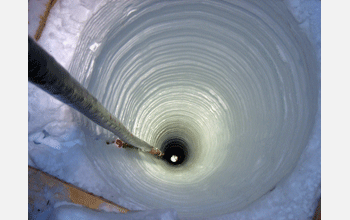Multimedia Gallery
Digital Optical Modules
View of signal cables from strings of digital optical modules that extend down into the ice, part of the IceCube Neutrino Detector. Elusive particles, called neutrinos, will be detected arriving from distant astrophysical sources and carrying information about those sources, just as rays of light reveal objects to conventional telescopes.
The IceCube Neutrino Detector is a neutrino telescope currently under construction at the South Pole. Like its predecessor, the Antarctic Muon and Neutrino Detector Array (AMANDA), IceCube is being constructed in deep Antarctic ice by deploying thousands of spherical optical sensors (photomultiplier tubes, or PMTs) at depths between 1,450 and 2,450 meters. The sensors are deployed on strings of 60 modules each, into holes in the ice that is melted using a hot water drill. The data that IceCube will collect will also contribute to our understanding of cosmic rays, supersymmetry, weakly interacting massive particles (WIMPS), and other aspects of nuclear and particle physics. To learn more, visit the IceCube Neutrino Detector website.
[IceCube is supported by the National Science Foundation under grant OPP 99-80474 (AMANDA) and OPP 02-36449 (IceCube).] (Date of Image: 2007)
Credit: Dr. Kathie L. Olsen, National Science Foundation
Images and other media in the National Science Foundation Multimedia Gallery are available for use in print and electronic material by NSF employees, members of the media, university staff, teachers and the general public. All media in the gallery are intended for personal, educational and nonprofit/non-commercial use only.
Images credited to the National Science Foundation, a federal agency, are in the public domain. The images were created by employees of the United States Government as part of their official duties or prepared by contractors as "works for hire" for NSF. You may freely use NSF-credited images and, at your discretion, credit NSF with a "Courtesy: National Science Foundation" notation.
Additional information about general usage can be found in Conditions.
Also Available:
Download the high-resolution JPG version of the image. (1.7 MB)
Use your mouse to right-click (Mac users may need to Ctrl-click) the link above and choose the option that will save the file or target to your computer.



